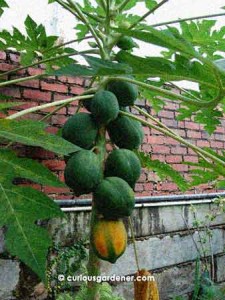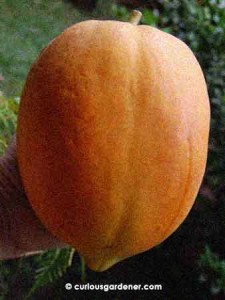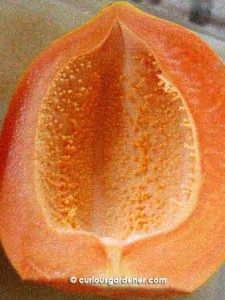It’s been a long journey, but we’ve finally reached the conclusion. In August 2010, I planted the first Red Lady papaya seeds. They germinated within days, and I thought it would be just a couple of months before they matured and started flowering.
Well, the plants grew well, but kept me in suspense for months before the first began to bud in January 2011. We ended up with four healthy trees, three of which are hermaphrodites (I assume, since they produced fruits without a male papaya tree around when they matured), and one male tree.
And once they started flowering, the trees kept it up for a few months before they finally began to set fruit. It wasn’t until late May that we finally saw the first little fruit on the tree. The other trees, growing at slower rates, started budding only towards the middle of the year – in fact, the last one just began to fruit in September!
Unbelievably to me, the fruits take about 4 months to mature on the tree. The first flower to set fruit bloomed in mid-May. We harvested the mostly-ripened fruit at the end of September and kept it wrapped in newspaper to ripen fully. Leaving it on the tree much longer would have tempted the birds to start pecking at it.
The harvested fruit – not the biggest growing on the tree – weighed in at just below 500 grams. It was quite a round fruit, the skin blushing a healthy deep orange colour.
To our surprise, it didn’t have any seeds when we cut it open. In retrospect, I’ve heard of this happening when there are no male trees around to pollinate the flowers. We will observe future fruits to see if this happens again. However, seeds are unimportant as I understand this is a hybrid and planting from seeds of this generation will not yield fruits of the same quality.
Red Lady papayas are supposed to have red flesh. Ours was basic papaya orange. But then it was also small, by the standards mentioned on the seed supplier’s website. Nevertheless, it was sweet! I presume that the first fruits, like eldest children, are guinea pigs – the result of the parent’s first attempt at reproduction. About 3 fruits up on that first tree is a much bigger, longer fruit. Maybe it got pollinated, or the parent tree finally got the hang of producing fruits.
Or maybe I need to fertilize the trees more aggressively. They had a good mulching when I first got my ton of compost, and again when the first layer of mulch decomposed. I also occasionally douse them with the fertilizer of the day, when I remember.
Maintaining the trees is fairly easy. Papaya trees do not like to be over-watered, so I didn’t trouble myself watering them unless we’d had an entire week without rain. As mentioned, I also did not fertilize them regularly. What I had to be religious about, however, was checking them daily for mealy bugs. While I used a white oil spray before they set fruit, I now remove the mealy bugs by hand, squishing them on the plants in the hopes that the scent of their dead brethren will scare away other mealy bugs. I can wish, anyway! If, however, I find leaves that are too infested, I cut them from the tree and dispose of them immediately.
Something I noticed was that the two trees that get the most sunlight produce more fruit. The last fruiting tree, not well placed in a somewhat shady location, sets fruit few and far between, and is a magnet for mealy bugs and black mould. I had another half-grown tree, also grown in a partly shady location, that was so infested with mealy bugs that I culled it.
My conclusion: plant the papaya tree in as sunny a location possible. So while we wait and see how the subsequent fruits turn out, I consider the our growing of the Red Lady papaya trees a success.
© 2011 curiousgardener.com All rights reserved.




Well done, yet again!!
A*
Thanks!